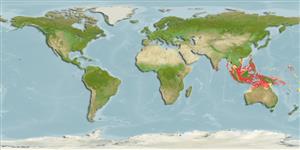>
Acanthuriformes (Surgeonfishes) >
Leiognathidae (Slimys, slipmouths, or ponyfishes) > Gazzinae
Eponymy: Dr Alan Morris Rapson (1912–2001) was (1952–1971) Chief of the Division of Fisheries, Department of Agriculture, Stock & Fisheries, PNG. [...] (Ref. 128868), visit book page.
Environment: milieu / climate zone / rango de profundidad / distribution range
Ecología
marino pelagic-neritic. Tropical
Indo-West Pacific: India and North Andaman I. to Indonesia and Papua New Guinea.
Tamaño / Peso / Age
Madurez: Lm ? range ? - ? cm
Max length : 6.7 cm SL macho / no sexado; (Ref. 5978)
Espinas dorsales (total) : 8; Radios blandos dorsales (total) : 16; Espinas anales: 3; Radios blandos anales: 14. This species of the Leiognathus splendens complex is distinguished by the following characters: cheek with scales; anterior dorsolateral body surface almost completely scaled; lower margin of inner preopercular ridge serrated; interspace of pelvic keels with scales; dark blotch on dorsal fin rather pale, grayish (Ref. 75583).
Body shape (shape guide): short and / or deep.
Life cycle and mating behavior
Madurez | Reproducción | Puesta | Huevos | Fecundidad | Larva
Kailola, P.J., 1987. The fishes of Papua New Guinea: a revised and annotated checklist. Vol. II Scorpaenidae to Callionymidae. Research Bulletin No. 41, Research Section, Dept. of Fisheries and Marine Resources, Papua New Guinea. (Ref. 6192)
IUCN Red List Status (Ref. 130435: Version 2025-1)
Threat to humans
Harmless
Human uses
Herramientas
Special reports
Download XML
Fuentes de Internet
Estimates based on models
Preferred temperature (Referencia
123201): 27.1 - 29.1, mean 28.3 °C (based on 1058 cells).
Phylogenetic diversity index (Referencia
82804): PD
50 = 0.5625 [Uniqueness, from 0.5 = low to 2.0 = high].
Bayesian length-weight: a=0.01905 (0.00853 - 0.04255), b=2.95 (2.76 - 3.14), in cm total length, based on LWR estimates for this (Sub)family-body shape (Ref.
93245).
Nivel trófico (Referencia
69278): 3.0 ±0.4 se; based on size and trophs of closest relatives
Resiliencia (Referencia
120179): Alto, población duplicada en un tiempo mínimo inferior a 15 meses (Preliminary K or Fecundity.).
Fishing Vulnerability (Ref.
59153): Low vulnerability (10 of 100).
🛈
